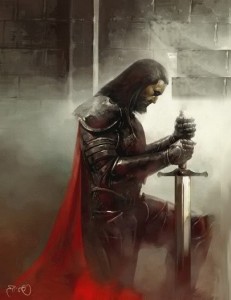Consciousness of God and remembrance of Him brings about a condition of tranquility in the soul; it is freedom from worry resulting from doubt: freedom from disquietude and from fear that refers to ultimate destiny; it is inward security that comes about when the soul is submissive to God. ~ Syed Naquib, Prolegomena
Valentin Tomberg tells us about Knights of Light:
The great Zarathustra wanted knights to fight under the banner of light in the struggle against darkness —the Turanian idolaters, the demons of impurity and ignorance, and lastly the spirit of Ahriman or Satan. He wanted that there should be people able to say yes to the light —and who, consequently, learned to say no to the darkness. ~ Meditations on the Tarot

Without that guiding light, a knight stumbles in the darkness or wanders aimlessly like a lion on the savannah. Ahriman is the supreme bureaucrat, who strives to organize everything to keep it in its place, to subdue it, to confine it to logic. Artificial intelligence is his dream and our nightmare.
Theosophy of light
Under the influence of figure like Kierkegaard, Nietzsche, Heidegger, inter alia, the West has come to associate spiritual depth with feelings of doubt, anxiety, dread, fear, absurdity, and so on. Nothing could be more wrong. On the contrary, real knowledge of God opens one up to ecstatic emotions. That is the proof that you know God with the knowledge of the heart; if you study metaphysics just as text, it becomes knowledge of the head. Henry Corbin describes Suhraswardi’s theosophy of light.
One of its essential features is that it makes philosophy and mystical experience inseparable: a philosophy that does not culminate in a metaphysic of ecstasy is vain speculation; a mystical experience that is not grounded on a sound philosophical education is in danger of degenerating and going astray. This element suffices to place Suhrawardi and Ibn Arabi in the same spiritual family. It situates this theosophy on a spiritual plane higher than the rational plane on which the relations between theology and philosophy, belief and knowledge, are ordinarily discussed. ~ Avicenna and the Visionary Recital
If you can explain it, then you don’t know it.
Knowledge of the Heart
The heart is regarded as the center of life, and from the physiological point of view, it is so due to its connection with the circulation of the blood. But it is further considered as a center on a higher plane in a more symbolical sense, through its connection with the universal Intelligence as related to the individual. It should be noted in this connection that the Greeks themselves, and Aristotle among others, assigned the same part to the heart, also making it the seat of intelligence, and not of feeling as the moderns commonly do. The brain is only the instrument of the mental faculty, that is, of thought in its reflective and discursive mode. The heart corresponds to the sun and the brain to the moon. ~ Rene Guenon, Man and his Becoming
The Universal Intellect
Islamic esoteric teaching going back to Suhraswardi, Ibn Arabi, Avicenna, and especially the Ismailis, depends heavily on Neoplatonism. The Ismailis had its roots with the Assassins, the rivals to the Templars. Because they had enemies even with other Muslims, they became very secretive. Their complete teachings are kept hidden from the public and known only to a small group,
The neoplatonic trinity consists of the Transcendent One (i.e., God), the Universal Intellect and the Universal Soul. Note the correspondence to Guenon’s Brahma, Buddhi and Manas in Man and his Becoming. The Christian concept of the Trinity is that the Universal Intellect and Soul are inseparable from the One. On the other hand, the Ismailis regard them as different beings, but less than God, more like angels. The Universal Soul is the Demiurge, as in Plato, the actual creator of the manifest universe. This conception is not too unlike early Arians, a version of Christianity adopted by the Germanic tribes during the Roman era.
It is not surprising that the Universal Intellect and Soul are angelic beings mediating creation. Laws along explain nothing, because they don’t answer the question, “Who is following the laws?” Ideas are passive and require a causal agent to have any effect. In the primal state of participatory consciousness, the world was experienced as populated by beings at different levels; even the planets were moved by angels. The modern world has forgotten all that; instead, it can only see a world of darkness, abstractions, and laws, in an Ahrimanic haze. Tomberg reminds us to look for the light:
Are laws, principles and ideas therefore not real? They are certainly real, but their reality is not that of an existence separate from beings, i.e., that of metaphysical entities populating a world or plane —a world of laws, principles and ideas—proper to themselves. The spiritual world is not a world of laws, principles and ideas; it is a world of spiritual beings — human souls, Angels, Archangels, Principalities, Powers, Virtues, Dominions, Thrones, Cherubim, Seraphim and the Holy Trinity: the Holy Spirit, the Son and the Father.
[youtube “https://www.youtube.com/watch?v=CM2PHJsn9xQ&t=6s”]
Nice post.
Maybe I’m insane, but once you get God into the mix, maybe there are worlds that could function without the eternal truths brought up in the video.
Anything possible, to some degree.
A stone and not a stone.